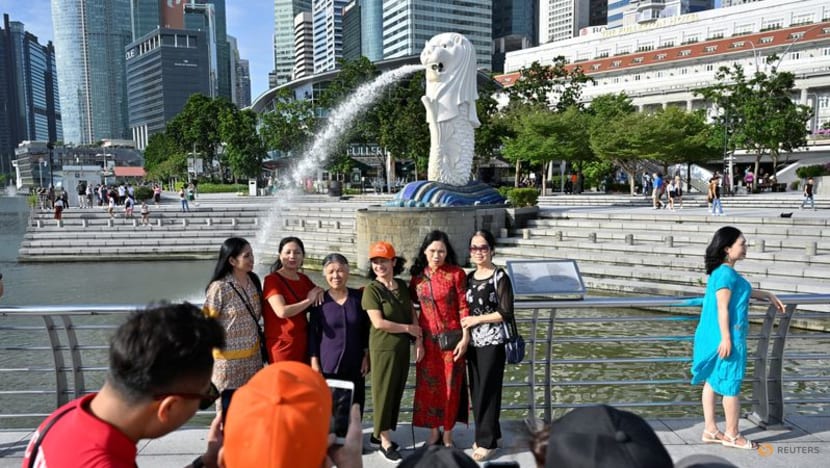Commentary: Why are Singapore visitor arrival numbers so slow to recover?
There is a widening gap between Changi Airport passenger traffic and Singapore visitor arrivals. The tourism sector needs to attract more tourists from Southeast Asia and India to restore visitor arrival growth and help Changi fill future terminals, says aviation and tourism analyst Brendan Sobie.

File photo. Tourists pose for photographs at Merlion Park in Singapore on Jan 27, 2023. (Photo: Reuters/Caroline Chia)

This audio is generated by an AI tool.
SINGAPORE: It is not every day that Singapore takes centre stage in a global music video. Last week, Coldplay dropped their latest music video - with iconic Singapore landmarks such as Marina Bay Sands, Gardens by the Bay, Jewel Changi Airport and the Singapore Flyer, alongside heartland spots such as MacPherson and Geylang featured prominently in the nearly 4-minute video.
On the same day Coldplay’s Man In The Moon music video was released, there was a separate announcement that Singapore had secured a multi-year deal to bring NBA basketball events to Singapore.
The Singapore Tourism Board (STB) has certainly been hard at work - it had a role in both developments, which reinforce Singapore’s reputation as a world-class travel destination. However, visitor arrivals have not yet recovered to pre-COVID levels.
Last week, STB released its 2024 results and 2025 outlook, projecting 17 million to 18.5 million international visitor arrivals this year after attracting 16.5 million visitors last year.
The good news is that STB achieved the top end of its 2024 forecast of 15 million to 16.5 million visitors, while tourism receipts are set to reach new highs.
STB forecasts S$29 billion to S$30.5 billion (US$21.4 billion to US$22.5 billion) in tourism receipts in 2025, compared with S$27.7 billion in 2019 before the COVID-19 pandemic. The final figure for 2024 will not be available for a few more months but is expected to have easily exceeded S$28 billion.
A CITY THAT DRAWS ATTENTION, BUT NOT ENOUGH VISITORS
The bad news is that if even if Singapore achieves 18.5 million visitor arrivals in 2025 - the top end of STB’s forecast - it would still be short of a full recovery compared to the pre-pandemic record of 19.1 million from 2019.
Meanwhile, passenger traffic - including arrivals, departures and transits - at Changi Airport has almost fully recovered at 67.7 million in 2024. Traffic will likely be 2 to 5 per cent above 2019 levels in 2025, but the conundrum is visitor arrivals are still lagging.
Of the 33.87 million passengers who landed at Changi in 2024, 13.52 million or 40 per cent were international visitors. In 2019, international visitors accounted for 14.88 million or 44 per cent of the 34.1 million passengers arriving at Changi.
The gap between Changi Airport passenger traffic and Singapore visitor arrivals seems to be accelerating as visitor arrivals were the weakest the last two months of the year. In both November and December, visitor arrivals at Changi were 15 per cent below 2019, while for the entire year, they were 9 per cent lower than pre-pandemic figures.
This is a concerning trend given Singapore’s massive investment in Terminal 5, which will boost Changi Airport’s capacity from the current 90 million to 140 million passengers per year by 2035. Construction of T5 is set to begin in the first half of this year.
Changi could reach 70 million passengers this year without a full recovery of visitor arrivals but will need significant growth in the inbound segment (visitor arrivals) to meet long-term aspirations.
The outbound segment (Singapore residents flying overseas) was 3 per cent above 2019 levels in 2024 but has limited growth potential given Singapore’s small population. Transit traffic, which was about 8 per cent above 2019 levels in 2024, can grow further but cannot alone fill T5.
So why are visitor arrivals still lagging and can anything be done to reverse the current trend?
PRICE-SENSITIVE TRAVELLERS
The reality is that demand for Singapore as a destination has declined among price-sensitive regional travellers from other Southeast Asian countries. Indonesian, Thai and Vietnamese travellers in particular are starting to holiday elsewhere.
Visitor arrivals from all three of these countries are significantly below 2019 levels. There was even a decline in Thai and Vietnamese visitor arrivals in 2024 compared to 2023 while all the other main markets registered year-over-year increases.
Vietnam experienced the steepest drop, with Vietnamese arrivals at Changi down 33 per cent in 2024 compared with 2019, including a 46 per cent decline in November and 42 per cent decline in December.
Thai visitor arrivals at Changi were 26 per cent below 2019 levels in 2024, including a 35 per cent drop in November and 29 per cent drop in December.
In the much bigger Indonesian market, visitor arrivals at Changi were down 16 per cent, including 22 per cent in November and 17 per cent in December.
Attracting more visitors from these and other Southeast Asian countries could require more budget accommodation options and a reduction in airport departure fees for regional travellers.
Another concern is India as Indian visitor arrivals at Changi were 13 per cent below 2019 levels in 2024 despite booming overall growth in India’s outbound travel sector, which other Southeast Asian countries have benefitted from. For example, Malaysia had 37 per cent more Indian visitors in 2024 compared with 2019.
The failure to achieve India growth is not only about Singapore’s high cost compared to other destinations but also visa-free policies. Singapore needs to lift visa restrictions to Indian citizens to compete with Malaysia, which adopted a visa-free policy for India in late 2023, and other destinations.
Singapore did adopt a visa-free policy for Chinese citizens in February 2024, which has aided the recovery of its biggest tourism source market. However, the impact has been somewhat mitigated by other Southeast Asian countries also lifting visa restrictions for China.
Chinese visitor arrivals at Changi were still 3 per cent below 2019 levels last year with very weak demand the last two months of the year. Chinese visitor arrivals at Changi were down 20 per cent in November 2024 and 23 per cent in December 2024 compared with the same months in 2019.
Indonesia, India and Malaysia are Singapore’s largest source markets after China. Malaysian visitor arrivals at Changi were down by 6 per cent in 2024 compared with 2019 but with also a concerning 24 per cent drop in December.
BEYOND BIG EVENTS
The weak performance at the end of last year highlights the challenges Singapore’s tourism sector faces in months when there are no major concerts or events.
The increased focus on attracting celebrity performers like Taylor Swift, Ed Sheeran and Coldplay will enable Singapore to continue generating record tourism receipts. A shift to higher value tourists - particularly from long-haul markets such as Australia, the United Kingdom and the United States - will also help keep the cash registers humming.
However, such strategies can create large gaps between the peaks and troughs, making it harder to fill up hotels and airport terminals on a consistent basis.
Singapore will need to find a way to start attracting more budget-conscious tourists, particularly from Southeast Asia and India.
Brendan Sobie is the founder of Singapore-based independent aviation consulting and analysis firm Sobie Aviation.





















